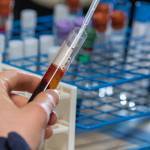Blood Collection, Processing, Storage Affect ACTH Levels in PPID Horses

Equine veterinarians often have time delays between collecting blood samples and sending them to a laboratory for analysis. Analytes in the blood sample—such as ACTH (adrenocorticotropic hormone), which is used to diagnose pituitary pars intermedia dysfunction (PPID, equine Cushing’s disease)—can potentially degrade if stored improperly, thereby affecting the diagnosis.*
Horses with mild PPID and only equivocal signs of disease may have ACTH levels close to the diagnostic cutoff value. If ACTH breaks down in the blood sample in the time between collection and analysis, the ACTH value will be artificially low when finally analyzed by the laboratory. As a result, that horse may not be diagnosed with PPID when in fact it is positive and requires treatment.
“Horses with PPID have enlargement of the pars intermedia region of the pituitary gland at the base of the brain. This region of the pituitary gland controls the release of various hormones and peptides, including ACTH. Horses with PPID have elevated ACTH levels that can be measured in a resting (basal) blood sample or following a thyrotropin-releasing hormone (TRH) response test,” said Ashley Fowler, Ph.D., a nutritionist for Kentucky Equine Research.
Horses with PPID require a timely diagnosis and treatment as untreated animals may be at risk of endocrinopathic laminitis.
Some laboratories recommend collecting blood, separating the plasma, and transferring that plasma into a cryovial. In clinical practice, however, equine veterinarians typically transfer the plasma to red top serum tubes instead.
To determine if ACTH is stable when plasma is transferred into red top tubes, blood samples were collected from 16 university-owned horses. Those blood samples were either collected to measure basal ACTH levels or following a TRH response test. All blood samples were collected into EDTA purple top tubes and centrifuged within two hours of collection. Plasma was removed from those samples and transferred to either a cryovial or a red top tube. ACTH was measured in samples stored at either 4° C (average refrigerator temperature) or 20° C (average room temperature), and samples were analyzed at 24 and 48 hours after collection.
There was no effect of type of tube (cryovial or red top serum tube) on ACTH levels, confirming that practitioners can safely use red top tubes to store plasma. However, time to analysis affected ACTH values.
“At both 4° C and 20° C, ACTH values decreased over time. In this patient cohort, three horses diagnosed with PPID would not have been diagnosed with PPID if the sample had been maintained at 20° C for 24 or 48 hours,” Fowler explained.
“To reduce the risk of false-negative results, it is recommended to collect whole blood into an EDTA tube and store it at 4° C until sample processing. The sample should then be centrifuged, and plasma should be stored in a serum [red top] tube for transportation to the laboratory if a laboratory-grade cryovial is not available and ideally analyzed within 24 hours,” concluded the research team.
Once diagnosed, horses with PPID often require aggressive medical management, including pergolide and sometimes dietary modifications.
“For horses with PPID that also have insulin dysregulation, dietary management can help reduce the risk of laminitis. Choose a hay that contains less than 10% nonstructural carbohydrates (NSC). If a low-NSC hay cannot be sourced, soaking the hay can reduce the NSC content,” recommended Fowler.
Adding a ration balancer will help meet essential minerals and vitamins requirements that are often lacking in hay, especially soaked hay. Ration balancers also contain high-quality protein. Along with an appropriate exercise program, high-quality protein can help support muscle mass.
*Johnston, T.J., A.J. Stewart, E.L. Dryburgh, and F.-R. Bertin. 2025. Time but not storage of equine plasma in silicate-coated tubes affects adrenocorticotropic hormone stability. American Journal of Veterinary Research 86(4):ajvr.24.11.0362.







